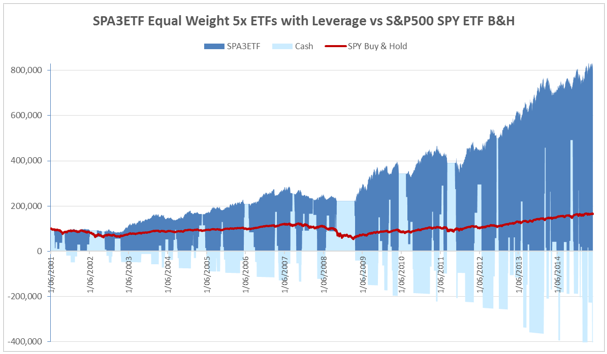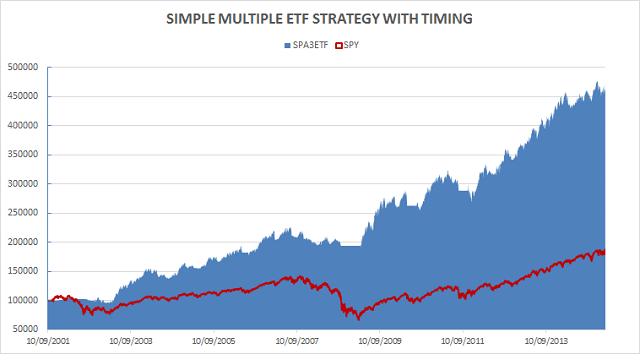Back on 12th March, I looked at introducing timing techniques to actively manage a portfolio of ETF’s rather than simply using a buy-and-hold approach. The 5 ETF’s included in the basket were the Mexican Bolsa, German DAX, NASDAQ 100, S&P600 Small Cap Index and NASDAQ Biotechnology Sector (ETF codes are EWW, EWG, QQQ, IJR, and IBB).
This unleveraged strategy produces the following equity curve (blue) versus buying and holding the S&P500 SPY ETF (repeated from the 12th March blog post Be your own fund manager (part 4) – the returns are really piling up now…).
I also promised I would discuss the effects of using leverage on this same basket of ETFs to show you the benefits of applying a manageable level of leverage to improve overall returns.
Leverage, as we know, can be a double-edged sword. Used correctly it can be a powerful tool to increase our exposure to the market and magnify positive returns. It can also obviously, magnify losses. Hence the need to always adhere to trading plan rules and take the SELL signals and exit positions so losses don’t get out of hand and become unmanageable.
In fact, leveraging an ETF or stock portfolio on a buy and hold basis can be very dangerous as all it takes is one decent bear market to cause potentially catastrophic outcomes.
The leverage ratio we have chosen to use is 1.6:1. This is the leverage ratio reportedly used by Warren Buffett. This “Buffett-like” level of leverage provides us with some extra “bang for our buck” but doesn’t over-extend our exposure and place us in the position of being required to meet margin calls on an ongoing basis as we could be if we were over-leveraged, or didn’t use exit strategies. The use of leverage will also increase maximum drawdowns but will be more than offset by far greater overall performance, provided not too much leverage is used, and exit strategies are followed.
To put the effort into perspective, an average of just 9 exits a year is required to execute this strategy.
This leverage ratio of 1.6:1 means that for every $1.60 we have invested in the market, $1.00 is ours, and $0.60 cents is borrowed.
The chart below shows the performance of this leveraged strategy v’s S&P500 SPY ETF Buy and Hold strategy. The performance speaks for itself. Over the same period the buy and hold strategy of the S&P500 SPY ETF (excl. dividends) produced an annualised gain of 3.66% and a total net gain of $65,000 with a maximum drawdown of -56.47%.
Not even in the ball park when compared to the returns from the leveraged ETF basket with 16.20% annualised gain, over $700,000 profit and a maximum drawdown of less than -26%.

Each of the equally weighted positions is leveraged at 1.6 : 1 and remains at that absolute leveraged position size until all positions have been closed due to an exit signal occurring. When a new entry signal next occurs the new leveraged position is calculated at the same leverage factor of 1:6: 1.
Even a quick glance at the 2 charts clearly shows the financial benefit of applying leverage to the SPA3ETF strategy and the extra performance generated.
The light blue areas show the borrowed monies at a 7.5% p.a. interest rate. A brokerage rate of US1.5 cents per share has been used.
The use of 1.6:1 leverage over the same 5 ETFs has increased our total return from $361,000 to just over $700,000 and the annualised gain has risen from 12.26% to 16.20% (excluding dividends). The maximum drawdown has also increased however from -17% to -26%.
These are the potential benefits for those that are prepared to take responsibility for their own retirement investments by putting in 15 to 20 minutes a week to do it themselves.
This is simply a better way to invest than entrusting your funds to others that don’t have the same personal passion for their investments as you do and whom charge continuously scaling fees for underperforming what is offer from the financial markets.



